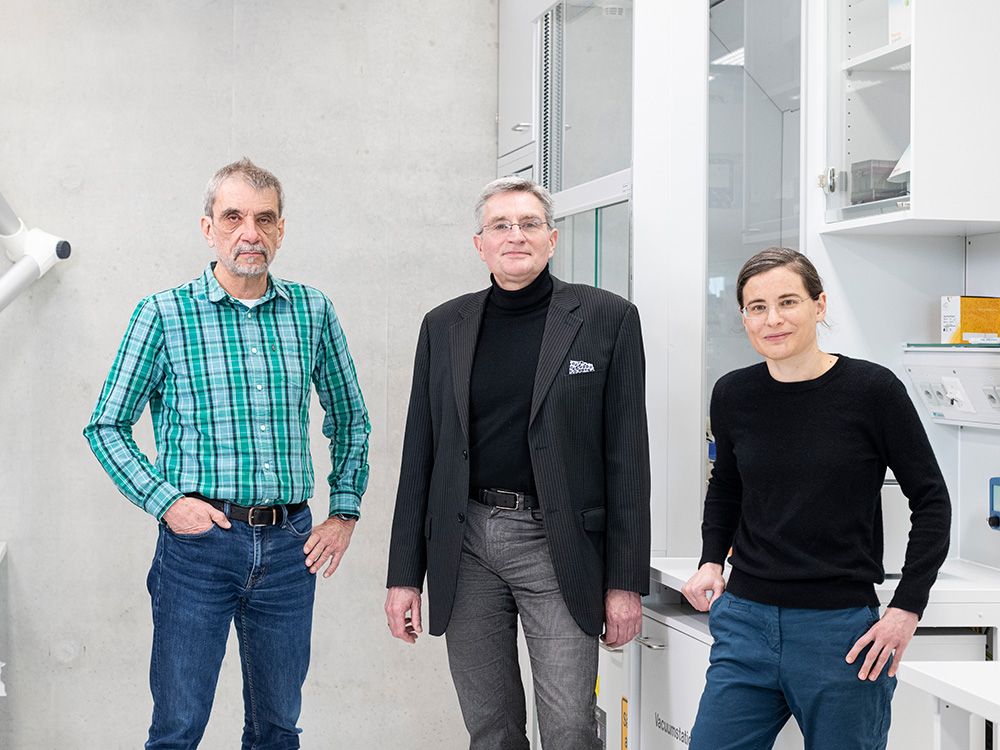The best hope for children with a rare muscle disease might just be a SEAL
The diagnosis is followed by despair — then maybe a glimpse of hope. When parents of a child with the genetic disease LAMA2-related muscular dystrophy search around online, one of the things they will encounter is SEAL Therapeutics, a start-up company at the University of Basel. What sounds like the name of a marine animal actually refers to a gene therapy that could one day lead to a significant improvement in affected children’s chances of survival.
29 February 2024 | Angelika Jacobs
Every one and a half years, on average, a child is born in Switzerland with a specific genetic defect that negatively affects the stability of their muscle fibers. This becomes apparent soon after birth, as affected children have almost no muscle tone and develop visible muscular atrophy over time. Their respiratory musculature is also affected, and many of the most severely affected children do not reach adulthood.
As yet, there are no effective therapies for LAMA2-related muscular dystrophy. Parents of children affected by this rare disease are actively involved in patient organizations in order to raise funds for research into therapeutic approaches. “I’ve been very impressed by this commitment, particularly given the challenges associated with their child’s disease. The rare nature of the disease creates a sense of togetherness that also inspires us as researchers,” says Dr. Judith Reinhard, who is in contact with patients and relatives through her research in collaboration with Professor Markus Rüegg at the Biozentrum of the University of Basel.
Fundamental research and an exciting idea
More than 20 years ago, their research began its life a long way from patient contact, however. Rüegg and his team of researchers explore the function of muscles or, more precisely, the role of specific molecules in the connections between nerves and muscles. One of the studied proteins is known as agrin and has revealed an interesting property: it is very good at binding to proteins on the surface of muscle cells.
What does this have to do with LAMA2-related muscular dystrophy? LAMA2 stands for the name of a gene that encodes the protein laminin-α2, which is defective in affected individuals. This protein normally acts as an essential “anchor” of the extracellular matrix - the “putty” between cells, that binds to muscle fibers and confers their stability. The researchers at the Biozentrum had a promising idea: might it be possible to use components of agrin to replace this anchor?
Now, more than two decades later, the team led by Markus Rüegg and Judith Reinhard has succeeded in developing a possible gene therapy that smuggles an optimized agrin component into muscles along with a second replacement protein to act as anchors. The fact that this took so long is primarily due to the lack of suitable methods of administering the replacement proteins. Now such methods have become available; these are modified viruses that serve as vehicles for replacement proteins, or rather for the blueprints for such proteins.
Experiments in mice have produced promising results, says Markus Rüegg: “When clinicians examine muscle sections from mice with the LAMA2 genetic defect, one with and one without our gene therapy, they’re blown away seeing the effect of our gene therapy approach.” Over time, the animals that received the gene therapy shortly after birth show more stable muscle tissue and significantly improved muscle mass and tone, as well as improved mobility and a longer lifespan.
Dedicated parents
This research was largely made possible by patient organizations in the US and Europe. Thanks to their funding, the Basel researchers regularly speak at conferences, where not only scientists and clinicians but also — above all — affected families meet to exchange information.
Judith Reinhard recalls that she initially shied away from contact with patients and relatives. Patient contact wasn’t part of her career plan as a scientist carrying out basic research in biology. But today she speaks of her great admiration for the parents she has met, who are dedicated advocates of research to better understand the disease and to develop possible treatment options — even though in some cases the results may arrive too late for their own child.
The project in collaboration with researchers from Rutgers University in New Jersey has now been incorporated within the start-up company SEAL Therapeutics. The acronym SEAL stands for Simultaneous Expression of Artificial Linkers and also ties in with the verb “to seal.” The company holds all of the patents, paving the way for further development of this gene therapy with a view to clinical applications.
Looking for pharmaceutical partners
The researchers are currently preparing the data they have collected so far in order to kick-start discussions with licensing authorities and ask what exactly will be needed to start clinical development and ultimately for approval. In addition, they are engaged in dialog with pharmaceutical companies that specialize in gene therapies, with a view to future collaboration.
Although clinical trials relating to rare diseases are not subject to the same minimum number of patients as for other medications, patience is nevertheless required. Development to the clinical stage will take time that parents and children with the disease today simply do not have. “When parents receive the diagnosis and search for information online, they come across our research and email us asking where they can secure treatment for their child,” says Rüegg. “They need the therapy right now, but unfortunately we have to tell them to be patient.”
Gene therapies have undergone a series of advances and setbacks in recent decades, “but I’m confident that we’ll solve the technical problems in the coming years,” says Rüegg. At least for the next generation of affected children, therefore, there is reason to hope that this potential treatment can be tested in a clinical setting.
Neglected and rare diseases
In a multi-part series of articles between International Neglected Disease Day (30 January) and Rare Disease Day (29 February), we highlight research at the University of Basel that aims to improve our understanding of such diseases and drive forward new therapeutic approaches.



